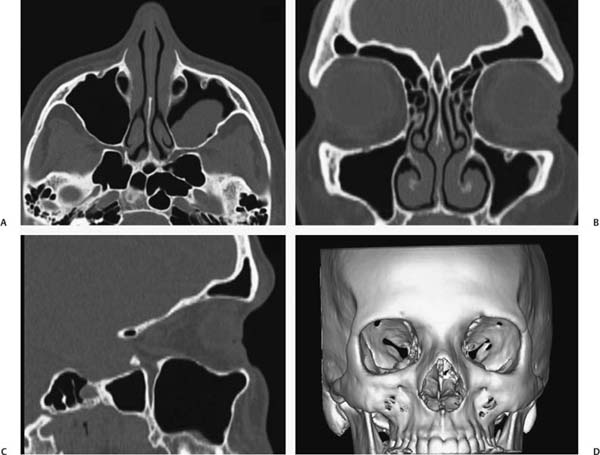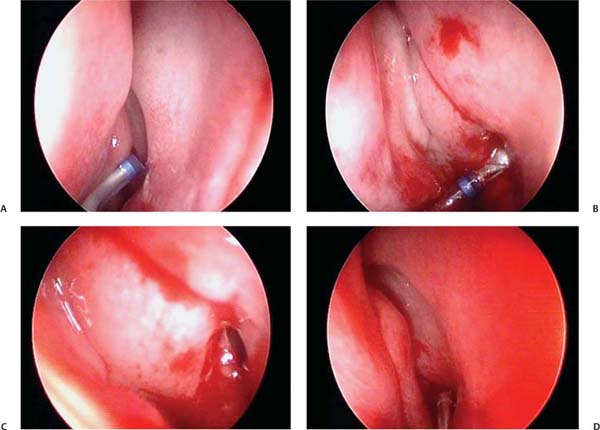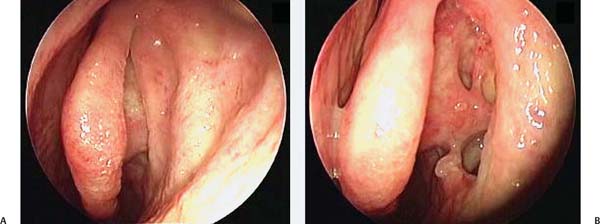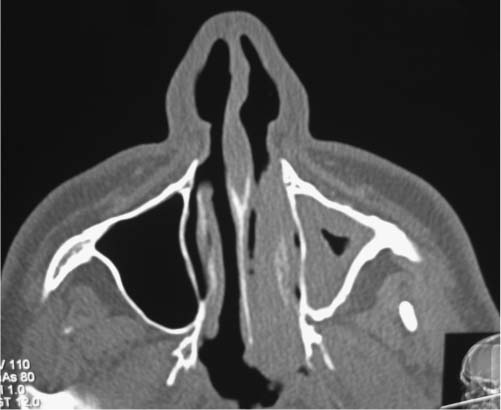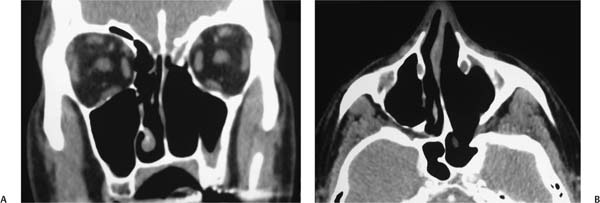18 Endoscopic Maxillary Sinus Surgery: From Minimal to Maximal The maxillary sinus is the largest of the paranasal sinuses; it is found in the body of the maxilla bone. It is bound medially by the lateral nasal wall, superiorly by the orbital floor, anteriorly by the canine fossa, and inferiorly by the alveolar process of the maxilla.1,2 The normally sterile maxillary sinus is lined by ciliated pseudostratified columnar epithelium covered by a double-layered mucous blanket. The deep layer lubricates the cilia, whereas the superficial layer captures foreign particles, which are transported by the cilia to the sinus ostium. Ciliary dysfunction or alterations in mucus composition can contribute to mucus stasis and subsequent infections.1,2 According to the studies of Zuckerkandl in 1882, the maxillary sinus ostium is usually shaped like a narrow ellipse, ranging from 3 to 19 mm (average 5 mm). Endoscopic visualization of the natural maxillary sinus ostium is uncommon because the ostium is frequently hidden by the intact uncinate process. On the other hand, “accessory” maxillary sinus ostia can be identified endoscopically. These accessory orifices are found in ~10% of the population and are located in the posterior fontanelle.1–4 Because it was first described by Leonardo da Vinci, the physiology and diseases of the maxillary sinus have been objects of medical interest. From a storage space for grease to lubricate the eyes’ movements, to the lightening of the weight of the skull, improving vocal resonance, absorbing shocks to the face or skull, to regulating intranasal pressure, the maxillary sinus has several functions. It also can be the cause of several illnesses, especially those closely related to the face, nose, and eyes.1–3 With advances in rhinology, the physiology and diseases of the maxillary sinus have been better described, and several surgical approaches have been proposed, both for the treatment of maxillary sinus diseases and for lesions involving the orbit, pterygoid, and infratemporal regions. Much has happened since the surgical approaches proposed by Caldwell and Luc to the era of the endoscopic surgery. In this chapter, we will present the most common endoscopic surgical procedures and approaches to the maxillary sinus, including balloon sinuplasty, minimally invasive sinus treatment (MIST) (see Video 18.1), conventional maxillary sinus antrostomy, medial maxillectomy and pterygoid surgical approaches. We will also discuss briefly the most frequent surgical indications, imaging and instrumentation, surgical complications, postoperative care and follow-up. The major indications for endoscopic maxillary sinus surgery are lesions that involve the maxillary sinus, the pterygoid and infratemporal regions, including maxillary cysts, antrochoanal polyps, barotrauma, mucocele, polyps, chronic rhinosinusitis, inverted papilloma, carcinoma, juvenile angiofibroma, tumors located into the pterygoid and infratemporal spaces, among others.5 Specific chapters of this book address the anatomy and imaging of the maxillary sinus. In general, computerized tomography (CT) of the paranasal sinuses is the best way to evaluate the anatomic parameters and diseases of the maxillary sinus. Axial and coronal views permit the identification of the uncinate process, nasolacrimal duct, orbit, infraorbital nerve, and diseases within the maxillary sinus itself or its adjacencies (Fig. 18.1). Sagittal reconstruction promotes the identification of the pterygoid fossa and its relationship with the maxillary sinus. The endoscopic maxillary surgery is usually performed with zero- and 45-degree endoscopes, and, in some cases, an endoscope of 70 degrees may be necessary. Although conventional endoscopic surgical instrumentation can also be used, some of the surgical instruments should be curved, and for infratemporal approaches, longer and thinner, but just as strong or stronger.6 Straight and curved suction cannulas should be available and we recommend a blunted edge cannula to avoid unnecessary trauma and mucosal bleeding. A micro-Kerrison punch is used to remove thin delicate bony plates. Monopolar and bipolar electrocautery permit the surgeon to control and minimize the bleeding. Powered instrumentation (i.e., microdebriders) is also important. Although not necessary, these instruments, which have multiple functions including suction, cutting, and irrigation, can be very useful during endoscopic surgery by improving the quality and presentation of the surgical field. At the present, newer instruments with curved blades and burrs, able to remove bone and debulk some tumors are commercially available. The newest microdebriders also produce a more precise cut of the diseased tissue, avoiding mucosal stripping, and are accompanied by continuous irrigation, which improves visualization and diminishes the loss of blood. However, these instruments also require more attention from the surgeon. They can be potentially more dangerous to the tissues, and doctors should be acquainted with these powerful instruments before using them. Fig. 18.1 (A–D) Paranasal sinus computer tomography(CT) scans. This is the best way to evaluate the maxillary sinus.(A) Axial cut to demonstrate the maxillary sinus relationships with the nasolacrimal duct and the pterygopalatine fossae.(B) Coronal view to evaluate the maxillary sinus relation to the orbit, infraorbital nerve, inferior turbinate, and uncinate process.(C) Sagittal reconstruction showing the pterygopalatine fossae.(D) Tridimensional reconstruction. Image-guided systems are precise and have been very helpful. These systems of tridimensional navigation provide important information about the location of anatomic structures in the operative field and create an individual anatomic map generated from preoperative computerized tomography. These image-guided systems help to diminish the chances of surgical complications because they provide the surgeon with the exact location of every instrument in the surgical field.6,7 The surgery is performed under hypotensive general anesthesia. The patient is placed in a supine position on the operating table, with the dorsum elevated 30 degrees and with the neck slightly flexed and the head extended and turned toward the surgeon. High concentration adrenaline-soaked cottonoids (1:1000) are placed into the nasal cavity for 10 minutes before the beginning of the surgical procedure. Balloon catheter dilatation is a recently introduced minimally invasive tool in rhinology that works with the concept of remolding the anatomy of the paranasal sinus ostia without removing tissue or bone. Its use in patients has proven to be feasible, safe, and the most important indications include chronic rhinosinusitis, barotrauma, and trauma, among others. The system, composed of several guide-catheters, a pumping bomb, a guide wire, and a balloon, uses the same principles commonly used in other medical specialties such as vascular surgery, urology, cardiology, and gastroenterology. The introduction of balloon catheters under fluoroscopic guidance, followed by high pressure inflation, results in dilatation of the sinus ostium.8–11 The maxillary sinus ostium is known as the trickiest for the introduction of surgical catheters because of its position, which is hidden behind the uncinate process. The catheter introduction is usually accomplished by softly displacing the uncinate process with a 90-degree maxillary guiding catheter, under 45-degree, 4-mm endoscope visualization (Fig. 18.2). The next step consists of fixing the position of the balloon. The balloon should be in contact with the entire circular edge of the maxillary sinus natural ostium. After positioning the balloon, it is inflated with ~8 to 10 atmospheres of pressure, resulting in dilation of the ostium. A catheter may also be used to provide suction and irrigation (Fig. 18.2). Usually, there is no mucosal tearing or bone exposure; therefore, no nasal packing is needed after the surgical procedure and the patient can be discharged on the same day.9–11 Balloon sinuplasty is a fairly new procedure and at this point, some controversies still exist. Further studies, complete with long-term follow-up should bring important information regarding results and the best indications for this surgical technique (see Video 18.2). Fig. 18.2 (A–D) Balloon catheterization and dilatation of the maxillary sinus natural ostium. (A) Positioning of the catheter. (B) Positioning of the balloon at the maxillary sinus natural ostium. (C) Endoscopic visualization of a 45-degree endoscope of the dilated maxillary sinus natural ostium. (D) Endoscopic view of the middle meatus after the procedure. This is probably the first and most important step in endonasal maxillary, ethmoid, and frontal endoscopic surgery. The uncinate process is removed to expose the anterior ethmoid and visualize the natural maxillary sinus ostium (Fig. 18.3). To ensure that this step is performed correctly and to prevent postoperative synechiae and iatrogenic complications, it is essential to understand the anatomy of the uncinate process.12,13 The uncinate process is a hook-shaped structure composed of a thin bony plate that is covered by mucosa on both sides and lies in an approximately parasagittal plane. It is attached anteriorly to the posterior edge of the lacrimal bone and inferiorly to the superior edge of the inferior turbinate. It has a free posterior border. Yoon et al (cited in Wadwongthan et al) described eight types of the posteroinferior portion of the uncinate process during anatomic studies of the fontanelle and uncinate process.14 There is still some controversy about the upper insertion of the uncinate process. Some authors believe that it ascends isolated to the lacrimal bone, skull base, lamina papyracea, or middle turbinate superiorly. We conducted a study that shows multiple superior insertions of the uncinate process. This has important technical implications, especially for endoscopic frontal recess and sinus surgery. With correct removal of the uncinate process, the natural maxillary sinus ostium can be seen (see Video 18.3).12–14 The following points should be noted in an endoscopic maxillary antrostomy. A common error is failure to expose the natural maxillary sinus ostium, instead creating a separate antral fenestration in the posterior fontanelle. The presence of this fenestration may interfere with normal mucociliary clearance, causing mucus recirculation from the natural ostium through the fenestration back into the maxillary sinus, leading to recurrent complaints. As a general rule, the maxillary sinus can be endoscopically evaluated with a 45-degree endoscope following exposure of the natural ostium. If this cannot be done, the natural ostium can be enlarged in the inferior or posterior direction with suitable instruments. Indications for enlarging the natural maxillary sinus ostium include nasal polyposis in cystic fibrosis or aspirin intolerance, maxillary sinus aspergilloma, and tumors such as juvenile angiofibroma and inverted papilloma. Endoscopic medial maxillectomy (EMM) is a procedure that may be indicated in some cases of inverted papilloma resection or for malignant sinonasal neoplasms restricted to the lateral wall of the nasal cavity or medial maxillary sinus (Fig. 18.4). Initially, this procedure was described for the treatment of inverted papilloma and was characterized by en bloc resection of the lateral nasal wall, including the inferior turbinate and the nasolacrimal duct, beside the middle turbinate and the anterior and posterior ethmoid sinus.15 The procedure begins with resection of the middle turbinate attachment on the lateral nasal wall following the dissection of the ethmoid sinus of the lamina papyracea and the ethmoid fovea until the rostrum of the sphenoid sinus. If necessary, the ethmoid arteries are cauterized with a bipolar cautery. After the liberation of the ethmoid sinus, the incision of the nasal mucosa is made at the attachment of the middle turbinate to the inferior meatus, including the resection of all of the uncinate process, the lacrimal bone containing the nasolacrimal duct, and the inferior turbinate; for this, the incision should pass anteriorly to the head of the inferior turbinate. After the elevation of the nasal mucosa, using a drill or osteotome, an osteotomy is made on the lateral nasal wall until the inferior meatus reaches the floor of the nose. An osteotomy is then made at the inferior meatus junction of the nasal floor to the posterior wall of maxillary sinus (Fig. 18.5). Fig. 18.3 (A) Endoscopic view of the middle meatus. (B) Visualization of the maxillary sinus natural ostium, after the uncinate process removal. This is probably the most important step in this surgical procedure. Fig. 18.4 Axial computer tomography(CT) scan of a paranasal sinus with nasal mucosa melanoma restricted to the lateral wall of the nasal cavity. Maxillar sinus with sinusitis due to occlusion of ostiomeatal complex. The nasal wall, along with the tumor, are both medially mobilized for the nasal cavity, with a dissection made inside the maxillary sinus. Posterior cuts separating the surgical piece of the posterior wall of the maxillary sinus are made, including cauterization of the sphenopalatine artery. The posterior attachment of the inferior turbinate is cut and the lateral wall along with the tumor is removed en bloc.15 Generally, the nasolacrimal duct is transected obliquely to avoid stenosis of the duct and epiphoras. The opening and the catheterization of the lacrimal sac during surgery is not necessary. Currently, EMM is utilized for the removal of sinonasal neoplasms and has several variations, one of which is the extended endoscopic medial maxillectomy (EEMM). In these cases, the resection of the posterior wall of the maxillary sinus can be made, permitting access to pterygomaxillary and pterygopalatine fossas. Extension of the surgery for other paranasal sinuses, such as the sphenoid and frontal sinus, can be made. More recently, the resection of the pyriform aperture has been described in association with EMM; being an anterior form of EEMM.16,17 In the endoscopic resection of the pyriform aperture, an anterior cut of the attachment of the inferior turbinate head on the mucosa that covers the frontal process of the maxilla is made. From the incision, the mucosa is removed and the free margin of the pyriform aperture is exposed. The separation of the mucosa and the periosteum from the anterior wall of the maxillary sinus can be elevated until the emergence of the infraorbital nerve. The anterior wall of the maxillary sinus is opened with a drill or osteotome and the frontal process of the maxilla is resected. When the pyriform aperture is resected, access to the maxillary sinus is maximized and the tumoral lesions with small invasions of the anterior and medial wall can be seen.16,17 In the event of an inflammatory disease or a benign tumor with inverted papilloma, resection can be less extensive, generally with preservation of nasolacrimal duct or with partial resection of the inferior turbinate. The procedure is then called a modified endoscopic medial maxillectomy.18 Yet, the vision of the maxillary sinus is limited in this situation. Anatomic studies evaluating the volume of the maxillary sinus demonstrate that with medial maxillectomy, when the nasolacrimal duct and the inferior turbinate are preserved, vision to the maxillary sinus is extremely restricted: almost 70% of the volume of the sinus is covered by inferior turbinate and nasolacrimal duct attachment.19 The resection of the nasolacrimal duct and the inferior turbinate permits an adequate view of the lateral wall and of the nasal floor as well, in cases where the nasal wall is inferior to the nasal wall cavity. Fig. 18.5 (A,B) Paranasal sinus computer tomography(CT) scan after a medial maxillectomy. (A) Coronal view showing the limits of the resection. (B) Axial cut demonstrating the limits of the medial maxillectomy resection. The maxillary sinus has thin walls that face the lower nasal cavity medially, the orbit superiorly, the infratemporal fossa posterolaterally, the pterygopalatine fossa posteromedially, and the soft tissue of the cheek anterolaterally. The maxillary sinus provides a transantral avenue for extending a midline surgical approach for more extensive lateral exposure of the cavernous sinus and the infratemporal fossa.20 The transmaxillary approach is excellent for removing lesions that involve the medial portion of the maxillary sinus, and for larger lesions in the pterygopalatine, zygomatic, or infratemporal fossae such as angiofibromas (see Video 18.4). This approach can also be extended to gain exposure to the cavernous sinus. The procedure begins with an anterior ethmoidectomy and continues with a wide middle meatus antrostomy to give maximal exposure of the posterior maxillary sinus wall. Sometimes it is necessary to remove the inferior turbinate, entirely resecting the medial wall of the maxillary sinus to obtain adequate exposure of the posterior and posterolateral wall of the sinus. During the removal of the inferior turbinate, special care must be taken to avoid injuring the terminal branches of the maxillary artery at the sphenopalatine foramen and the second division of the trigeminal nerve.20–22 The amount of posterior wall bone to be removed depends on the location and extent of the lesion as determined by preoperative image studies or by information from the image-guided system at the time of surgery. The posterior wall of the maxillary sinus can be opened by enlarging the sphenopalatine foramen with a micro-Kerrison punch and exposing the periosteum of the pterygopalatine, zygomatic fossae, and infratemporal fossae. It is important to try to preserve the integrity of the periosteum and avoid fat protrusion into the operative field. If fat does protrude into the sinus, it is reduced by bipolar electrocoagulation, which also is used to control any bleeding. This technique is particularly useful in removing angiofibroma when early identification of the feeding vessels is essential. The transpterygoid and infratemporal accesses are extensions of the transmaxillary access. In the transpterygoid approach, lateral extensions of the sphenoid sinus (pterygoid recess) and lesions involving the pterygopalatine fossa and zygomatic fossa can be accessed. This may require removal of the medial and sometimes lateral pterygoid processes to achieve access to the lateral and pterygoid regions of the sphenoid sinus. A wide sphenoidotomy is also performed at the beginning or during the surgical operation. This access allows treatment of lesions involving the cavernous sinus that are lateral to the paraclival internal carotid artery. The infratemporal access adds a medial endoscopic maxillectomy. In this surgical access, we resect the posterior wall and sometimes the lateral wall of the maxillary sinus, particularly in situations with lateral expansion of the lesion. Endoscopic maxillary sinus surgery is currently considered the gold standard surgical approach for the treatment of many lesions involving the maxillary sinus and its adjacent structures. This surgical approach may vary from very minimal invasive procedures to large and extensive resections. The surgeon’s final choice must be made based on the patient’s disease, the surgeon’s experience, and the availability of the necessary instrumentation. • The maxillary sinus is the largest of the paranasal sinuses. • There are several surgical approaches to the maxillary sinus; the surgeon’s choice should be based on experience, type and extension of the disease, and the availability of the necessary instrumentation. • The maxillary sinus antrostomy is bounded by the nasolacrimal duct anteriorly, the orbital floor superiorly. This is important to remember when approaching the sinus surgically. • Straight and angled endoscopes(30- or45-degree) are paramount for any endoscopic maxillary sinus surgery. • One of the most common causes for maxillary sinus revision surgery is the lack of inclusion of the natural ostium at the prior antrostomy. • This principle is also valid for other minimal invasive endoscopic surgeries, such as balloon sinuplasty, MIST, and medial maxillectomy. A careful look at the natural ostium must always be a step in the procedure.
 Surgical Indications
Surgical Indications
 Imaging
Imaging
 Instrumentation
Instrumentation
 Surgical Techniques
Surgical Techniques
Balloon Sinuplasty
Maxillary Antrostomy
Endoscopic Medial Maxillectomy
Infratemporal Approach
 Conclusion
Conclusion
Endoscopic Maxillary Sinus Surgery: From Minimal to Maximal
Pearls
< div class='tao-gold-member'>Only gold members can continue reading. Log In or Register to continue

Full access? Get Clinical Tree


